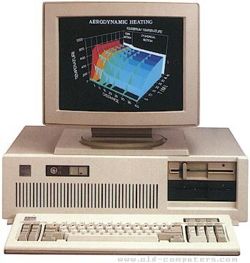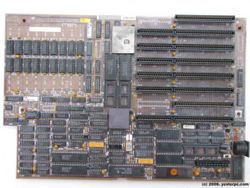Difference between revisions of "IBM AT"
(added info box...) |
m |
||
| Line 13: | Line 13: | ||
[[Image:IBM 5170 motherboard.jpg|thumb|right|250px|IBM AT Motherboard]] | [[Image:IBM 5170 motherboard.jpg|thumb|right|250px|IBM AT Motherboard]] | ||
| − | The IBM AT unlike the [[IBM XT]], the AT is fully 16 bit, with a 16bit memory bus, 24 address bus, and 16bit expansion bus. IBM had also promised along with the AT, that it would support the next generation of operating systems, [[OS/2]]. The AT was also able to run [[Xenix]], along with a special protected mode version of Xenix. | + | The IBM AT unlike the [[IBM XT]], the AT is fully 16 bit, with a 16bit memory bus, 24 address bus, and 16bit [[ISA]] expansion bus. IBM had also promised along with the AT, that it would support the next generation of operating systems, [[OS/2]]. The AT was also able to run [[Xenix]], along with a special protected mode version of Xenix. |
All BIOS's with computers with a 286 or greater CPU are compatible with the IBM AT. | All BIOS's with computers with a 286 or greater CPU are compatible with the IBM AT. | ||
Revision as of 18:53, 7 August 2010
| IBM 5170/IBM AT | |
 An IBM AT | |
| Manufacturer: | IBM |
|---|---|
| Year Introduced: | 1984 |
| Word Size: | 16 bit |
The IBM AT, also known as the IBM 5170 was the machine that introduced 16 bit ISA slots, and the 'advanced' i286 CPU.
Until the rise of the Pentium II CPU, the IBM AT motherboard was the standard size for clone motherboards with 286 and greater CPUs.
The IBM AT unlike the IBM XT, the AT is fully 16 bit, with a 16bit memory bus, 24 address bus, and 16bit ISA expansion bus. IBM had also promised along with the AT, that it would support the next generation of operating systems, OS/2. The AT was also able to run Xenix, along with a special protected mode version of Xenix.
All BIOS's with computers with a 286 or greater CPU are compatible with the IBM AT.
The IBM AT shipped with a WD-1002 controller, that supported MFM hard disks, but unlike other controllers, the control code was in the IBM AT, and the drive parameter table was burned into the BIOS, and the selection was saved into the non volatile ram. The AT also required a special diskette to setup the NVRAM, while clones typically didn't include the ROM BASIC, and instead included a setup & diagnostic program in ROM.
The IBM AT was later supplanted by the PS/2 line of computers.
